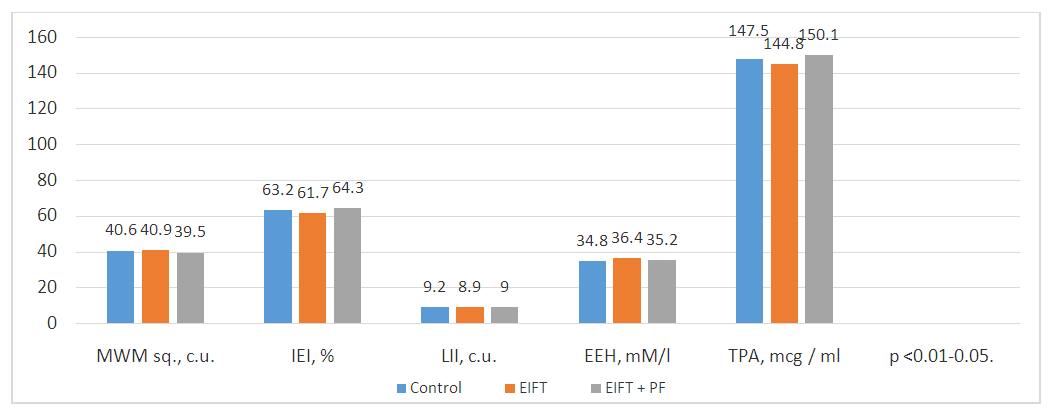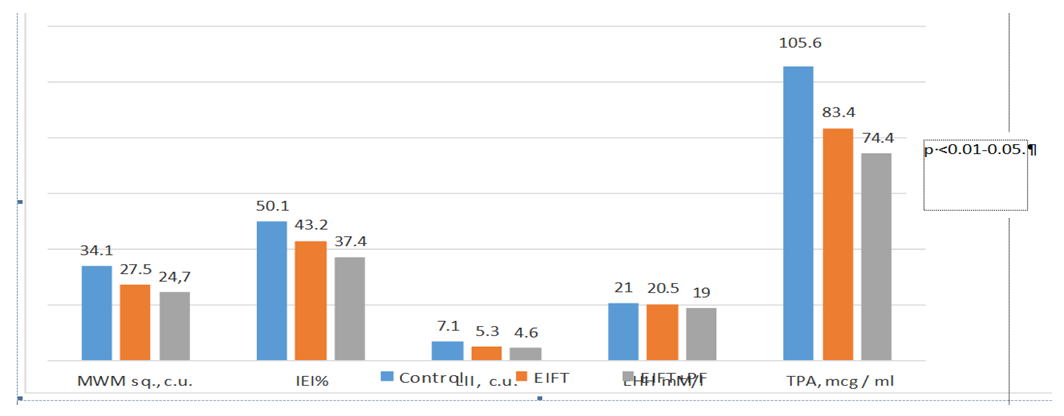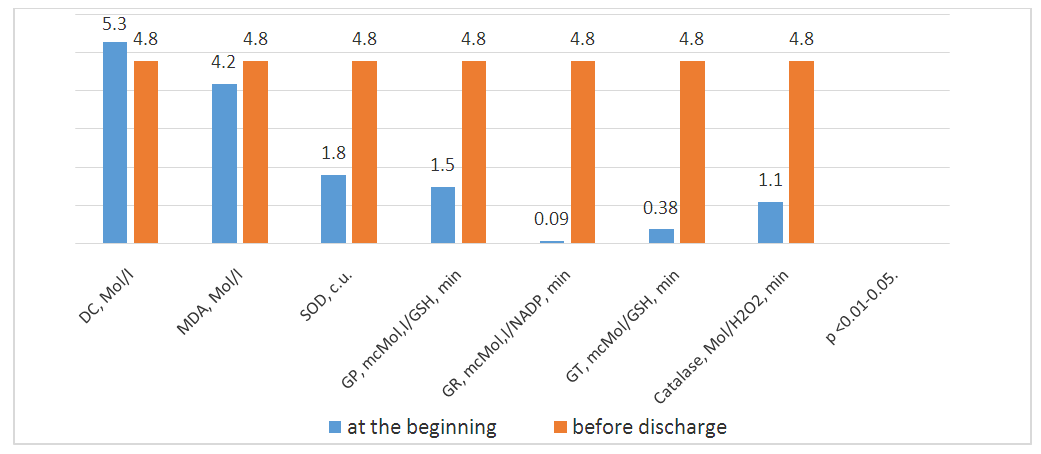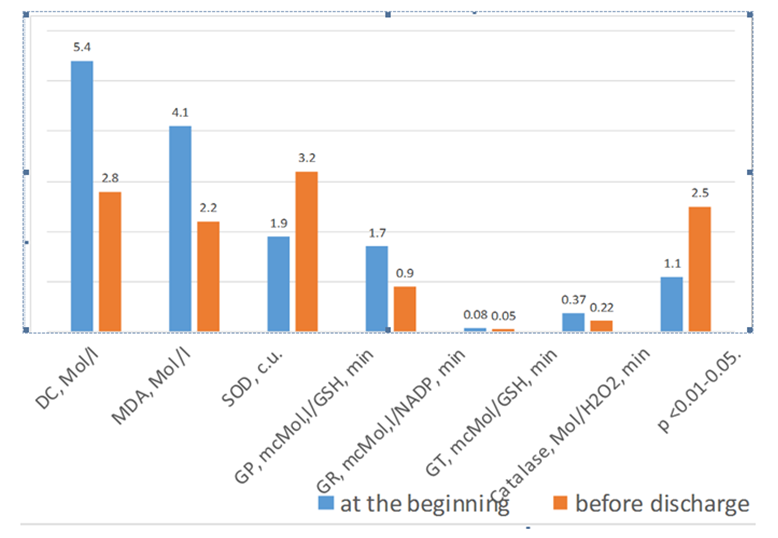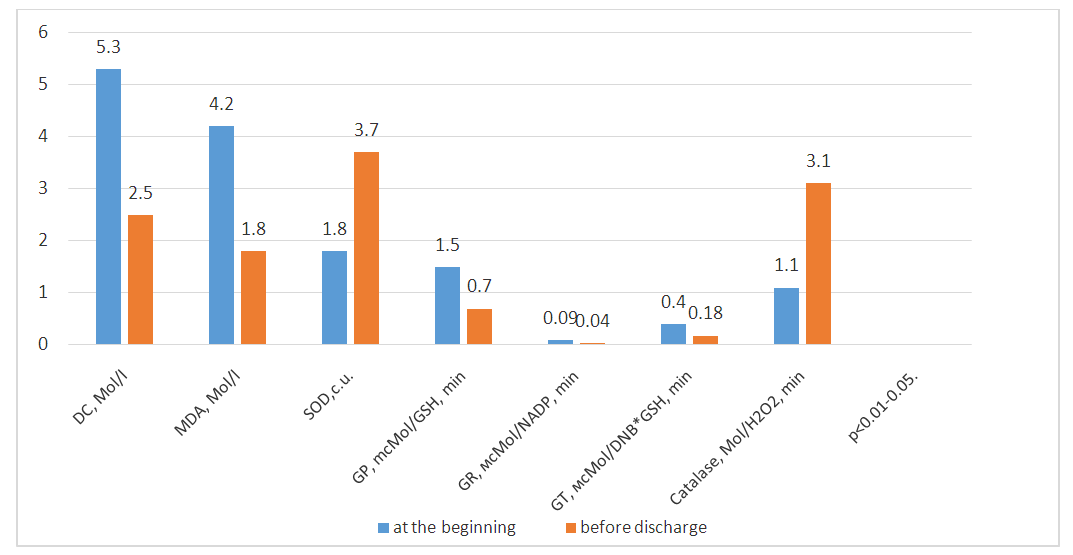-
Paper Information
- Previous Paper
- Paper Submission
-
Journal Information
- About This Journal
- Editorial Board
- Current Issue
- Archive
- Author Guidelines
- Contact Us
American Journal of Medicine and Medical Sciences
p-ISSN: 2165-901X e-ISSN: 2165-9036
2019; 9(6): 217-223
doi:10.5923/j.ajmms.20190906.09

The Effect of Extracorporeal Immunopharmacotherapy on Intracellular Metabolism in Cervical Cancer Patients
Kamishov Sergey Viktorovich, Tillyashaykhov Mirzagaleb Nigmatovich
Republican Specialized Scientific and Practical Medical Center of Oncology and Radiology of the Health Ministry of the Republic of Uzbekistan, Tashkent
Copyright © 2019 The Author(s). Published by Scientific & Academic Publishing.
This work is licensed under the Creative Commons Attribution International License (CC BY).
http://creativecommons.org/licenses/by/4.0/

The aim of the research was to study the effect of supportive immunotherapy in the form of extracorporeal immunopharmacotherapy on the parameters of intracellular metabolism in 163 patients with cervical cancer of II-III clinical stages. All patients received complex treatment, including polychemotherapy, surgery and radiation therapy. In patients with cervical cancer under the influence of extracorporeal immunopharmacotherapy an evident decrease of the intoxication biochemical indices was observed. The imbalance in the systems of lipid peroxidation and antioxidant protection has significantly decreased. Clinically it was possible to reduce the degree of radiation complications of the pelvic organs. A significant effect of extracorporeal immunopharmacotherapy was an improvement of the patients life quality which was reflected in an increase of the physical and mental components of health. At the same time, there was a noticeable increase in both the overall 5-year survival of patients and the median of progression-free survival and the median of overall survival while reducing the observed ratio of the risk of disease progression and the risk of death. It has been revealed that the immunopharmacotherapy scheme has the highest efficiency including intermittent plasma exchange with subsequent extracorporeal immunopharmacotherapy.
Keywords: Antioxidant protection, Glutathione-S-peroxidase (GP), Glutathione-S-reductase (GR), Glutathione-S-transferase (GT), Catalase (CT), Leukocyte index of intoxication (LII), Median survival, Lipids peroxidation (LPO), Plasmapheresis (PF), Polychemotherapy (PCT), Cervical cancer (CC), Total peroxidase activity (TPA), Superoxide dismutase (SOD), Extracorporeal immunopharmacotherapy (EIFT)
Cite this paper: Kamishov Sergey Viktorovich, Tillyashaykhov Mirzagaleb Nigmatovich, The Effect of Extracorporeal Immunopharmacotherapy on Intracellular Metabolism in Cervical Cancer Patients, American Journal of Medicine and Medical Sciences, Vol. 9 No. 6, 2019, pp. 217-223. doi: 10.5923/j.ajmms.20190906.09.
Article Outline
1. Introduction
- In recent years the interest in the use of various methods of immunotherapy in clinical practice for treating oncological diseases is growing worldwide and it is a scientifically justified treatment method. It is known that malignant tumors develop on the background of systemic disorders of the immune system, arising already in pretumor diseases [1-5]. As knowledge of the capabilities of the immune system in the fight against cancer began to deepen, treatment methods using the immune system against malignant tumors began to develop. Despite the fact that immunotherapy of malignant tumors is a relatively new scientific field the results obtained during the last decade allow us to count on the important role of immunotherapeutic approaches in the treatment of cancer. Currently immunotherapy is one of the most promising areas in the treatment of malignant tumors which includes the treatment of tumors with monoclonal antibodies, anti-tumor vaccines, cytokines, activated lymphocytes and other methods [6-8]. However, a rather complex issue in the study of the effectiveness of the use of immunotherapy methods is the correct assessment of the advisability for administering immunotropic treatment and its effectiveness [9]. It should be noted that one of the methods which has been successfully used for the treatment of allergic diseases as well as intoxication for a long time is therapeutic plasmapheresis (PF). It consists of removing blood plasma containing antibodies which are “guilty” in the development of the disease, circulating immune complexes, cytokines, products of cell metabolism. The main mechanism that provides the curative effect of PF is the deplassion of cellular elements. Pathological elements adsorbed on the cell surface are removed along with the plasma, the vital activity of the cells changes, new interactions with other cells and regulatory facts arise [10]. Modern methods of extracorporeal immunopharmacotherapy (EIFT) are an effective extension of therapeutic PF. An additional release of the leukocyte fraction occurs with EIFT, which is then processed outside the body with a specific drug aimed at increasing or decreasing (depending on the disease) the functional activity of the participating cells of inflammation and immune reactions. This method is successfully used in the treatment of patients with severe septic processes, as well as in patients with different variants of immunodeficiency states. It should be noted that the effectiveness of these methods is incomparably higher than the efficiency of traditional methods of drug treatment of the immune system functions acquired disorders [11-14]. Methods of immunotherapy in the treatment of malignant tumors can have a normalizing effect on the immune status of cancer patients which is manifested clinically by the regression of tumor pleurisy and ascites in chemoresistant cancers. Unlike conventional methods of immunotherapy, EIFT allows to selectively isolate from the blood directly the cells of the immune system - mononuclear cells. This direction of immunotherapy has great prospects in oncological practice in connection with the ability to remove the effects of cancer and chemoradiation intoxication as well as to activate the body’s own system of antitumor defense [15]. However, there is very little information in the literature about the use of the EIFT method in the treatment of cancer. At the same time, this method in the field of oncology is still used empirically, since there are no clear criteria for indications and contraindications in the treatment of malignant tumors of various localizations. The main purpose of our research was to study the effect of supportive immunotherapy with the EIFT method on intracellular metabolism in patients with cervical cancer (CC) of stages II-III.
2. Aim
- To study the effect of supportive immunotherapy with the EIFT method on intracellular metabolism in patients with cervical cancer (CC) of stages II-III.
3. Materials and Methods
- 163 patients with cervical cancer of II-III clinical stages of the disease who were undergoing treatment at the oncologic and gynecological department of the Republican Specialized Scientific and Practical Medical Center of Oncology and Radiology (RSSPMCOR) from 2004 to 2014 were examined. Histological examination of the surgical material and the results of biopsy in patients with cervical cancer identified squamous cervical cancer. Mean age of the patients was 45.7 ± 7.07 years. All patients received combined and complex treatment including polychemotherapy (PCT), surgery and radiation therapy (RT). At the first stage, patients with cervical cancer have received systemic or intraarterial PCT using the cisplatin 50 mg / m2 + 5-fluorouracil 1000 mg / m2 for 4 days in 4-6 courses 1 time in 3 weeks. PCT was performed both in neoadjuvant and in adjuvant regimens. The second stage included surgery in a radical volume or combined radiation therapy using a radical program. At the third stage RT was performed which included remote telegammatherapy (RTGT) and intracavitary brachytherapy. DTGT was performed on a “Theratron” or “AGAT-R” apparatus in a split course with a fraction dose (FD) of 2 Gy to total dose (TD) of 50 Gy, 5 times a week. Brachytherapy was performed on a “Gammamed” device with a FD of 5 Gy to TD of 45-55 Gy every other day [8.20]. The patients were randomized as follows: the 1st (control) group there were patients with cervical cancer who had not received immunotherapy; the 2nd group - patients with cervical cancer who underwent EIFT by exfusion of 200-250 ml of auto blood into “Gemakon” or “Terumo” sterile containers, incubation with an Neovir immunomodulator in a total dose of 750 mg (for 3 procedures), at 37°C for 60 -100 min with the subsequent return of the conjugate to the circulatory system of patientsin; in the 3rd group of patients, the EIFT method was used and it was an extension of plasmapheresis (PF) capabilities. 500-1000 ml of auto blood were placed in “Gemakon” or “Terumo” sterile containers, then plasma extraction was performed, the blood cells mass and red blood cells were separated by centrifugation at 3000 rpm for 30 minutes. 50-80 ml of the supernatant layer of blood plasma containing antibodies, circulating immune complexes, cytokines, and products of cell metabolism were removed. Then, the obtained blood cells mass and erythrocyte mass were incubated with an immunomodulator similarly as in the 2nd group of patients and the conjugate was reinfused [16]. For biochemical studies, blood was collected in patients from the cubital vein, on an empty stomach, in an amount of 3-5 ml. After centrifuging for 10 minutes at 3000 rpm, the blood was divided into plasma and red blood cell mass which was used immediately for analysis or frozen and stored at t −10°C. In order to study the toxicity of the body’s medium, accumulation processes and levels of endogenous intoxication marker molecules, the concentration of polypeptides medium weight molecular (MWM) in plasma was studied by spectrophotometry at a wavelength of 254 and 280 nm [17]. The evidence level of endogenous intoxication index (EII) was estimated by the effects of the biological impact of endotoxins on cell membranes [18]. The membranotropic action of endotoxins was established according to such a parameter as the leukocyte index of intoxication (LII) according to Kalf-Kalif [19-21]. The stability of erythrocyte membranes was assessed by the level of extra-erythrocyte hemoglobin (EEH) and total peroxidase activity (TPA) in blood plasma [22]. To determine the activity of antioxidant enzymes in erythrocytes, the enzymes were washed 3 times from plasma by dilution 10 times with cold saline solution and centrifuged again at 2000 rpm at 40°C. Hemoglobin which interferes to determine the enzyme activity is precipitated with a mixture of alcohol and chloroform [23]. The concentration of malonodialdehyde (MDA) was determined by L.I. Andreeva (1988). The activity of superoxide dismutase (SOD) was determined by the method of reducing the rate of nitrosynogtetrazolium reduction in the presence of nicotinamide-adenine dinucleotide phosphate (NADP) (NADP-dehydrogenase complex, also called complex I or NADP - ubiquinone-oxidoreductase - the first multi-protein complex of respiratory electron transport chain - nicotinamide adenine dinucleotide) and phenazine metasulfate [24]. The level of diene conjugates (DC) was evaluated by the ratio of isopropanol extracts absorption intensity at wavelengths of 215, 220 and 232 nm. Catalase activity was determined by the method based on the ability of hydrogen peroxide to form a stable colored complex with molybdenum salts according to A.I. Karpischenko (1999). The activity of glutathione-S-transferase (GT) was determined by the rate of formation of glutathione-S-conjugates between GSH and 1-chloro-2,4-dinitrobenzene (DNB) according to A.I. Karpischenko (1999). The activity of glutathione-S-peroxidase (GP) was determined by the rate of utilization of hydrogen peroxide due to oxidation of glutathione. The activity of glutathione-S-reductase (GR) was determined by Harutyunyan et al. (2000). The study of enzyme indicators were carried out in the Republican Scientific Center of Immunology of the Health Ministry of the Republic of Uzbekistan. Laboratory parameters were studied in patients before the course of immunotherapy and immediately before discharge from the hospital. Statistical processing of the material was performed using the "Statistica 6.0" computer program. The significance of differences between two samples with a normal distribution of values was performed using Student's f-test.
4. Results and Discussions
- During chemotherapy in the examined cervical cancer patients toxicity was observed: anemia, leukopenia, lymphocytopenia, appetite deterioration, nausea, vomiting, taste disorders, and alopecia were the most common. RT in patients with cervical cancer, as a rule, was accompanied by the development of radiation reactions from the critical pelvic organs - the urinary bladder and rectum. As it follows from the presented diagrams (Fig.1,2), under the influence of EIFT, an evident decrease in the content of medium weight molecules (MWM) in the blood plasma of patients was observed in comparison with the control group. The MWM fraction includes hormones, neuropeptides, mediators of the immune response and other products of protein metabolism, which determines its high biological activity and is one of the indicators of endogenous intoxication. At the same time, in the patients with cervical cancer MWM containing aromatic amino acids were more often identified (absorption at 280 nm). A more adequate relief of the degree of endotoxic syndrome evidence in the group of patients who were used methods of immunotherapy as an supportive treatment was also indicated by the intensity of improvement dynamics indices of endogenous intoxication (EI), leukocyte intoxication index (LII), the state of cellular destruction of tissues according to the level of extra-erythrocytic hemoglobin (EEH) and a decrease in total peroxidase activity (TPA), which is mainly caused by neutrophils generating active forms of oxygen.
|
5. Conclusions
- In patients with cervical cancer under the influence of EIFT an evident decrease in the biochemical indices of intoxication was observed in comparison with the control group without immunotherapy. This made it possible to significantly reduce the imbalance in the LPO / AOP systems caused by both the main disease and the chemoradiation effect which increases the level of hydroperoxides in the body. The use of EIFT methods in the supportive treatment of patients with cervical cancer has greatly reduced their degree of radiation complications of the urinary bladder and rectum. The research concludes that an important effect of immunotherapy was an improvement in the life quality of patients which was expressed in increasing the physical component of health - by 91.0 and 100.9 points and the mental component of health - by 44.1 and 63.2 points for EIFT and EIFT groups in combination with plasmapheresis accordingly in comparison with the control group. The overall 5-year survival of patients using the EIFT method increased by 10.6% in compare with the control group and the use of the EIFT in combination with PF increased by 15.6%. When using immunotherapy methods the median survival without progression (PFS) increased by 1.5 and 2.0 months, the median overall survival (OS) of patients increased by 1.1 and 1.8 months and the observed risk ratio (HR) of the disease progression decreased by 26.3% and 35.1% and the observed death risk ratio - by 8.9% and 14.5%, respectively. The most effective in the combined treatment of patients with cervical cancer of stages II-III is an immunotherapy scheme that includes intermittent plasmapheresis with subsequent EIFT which reduces the main clinical manifestations of chemotherapy toxicity, the severity of radiation complications increases quality and duration of their lives.

 Abstract
Abstract Reference
Reference Full-Text PDF
Full-Text PDF Full-text HTML
Full-text HTML